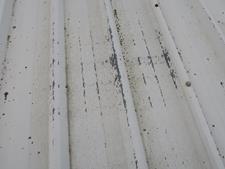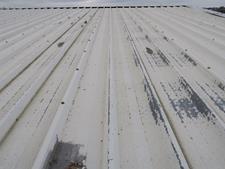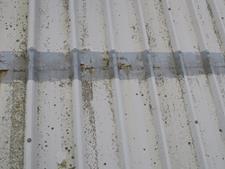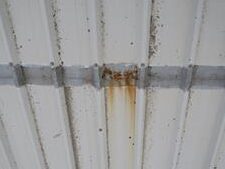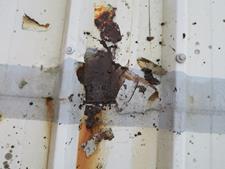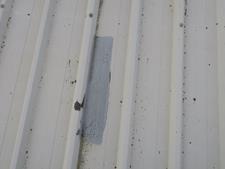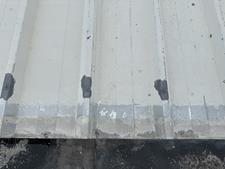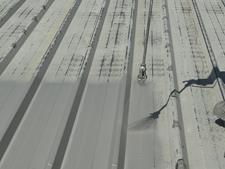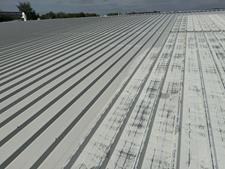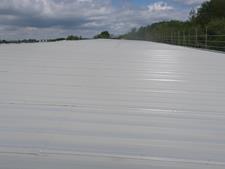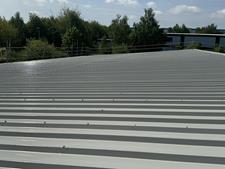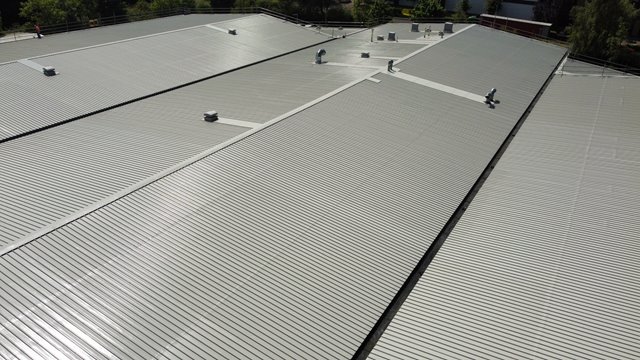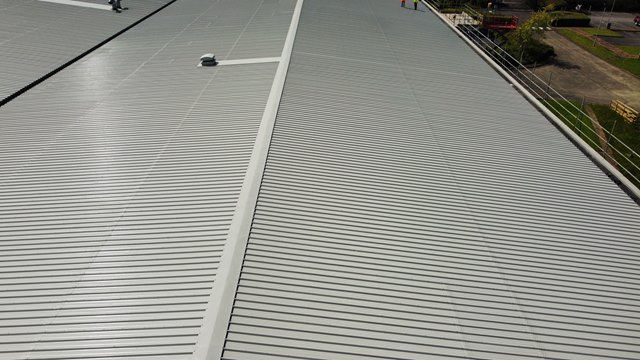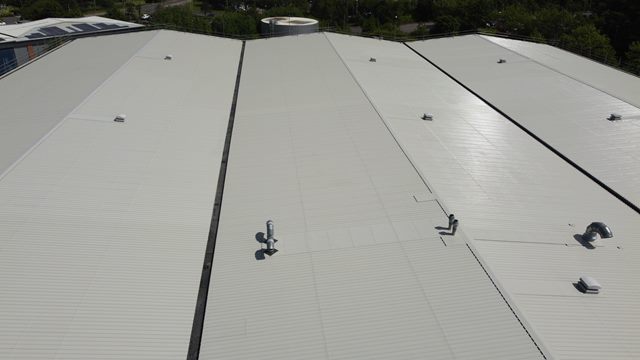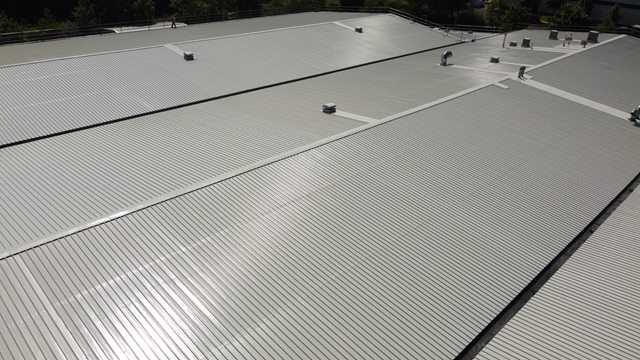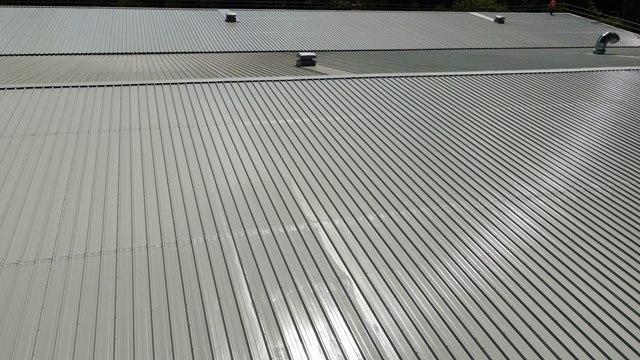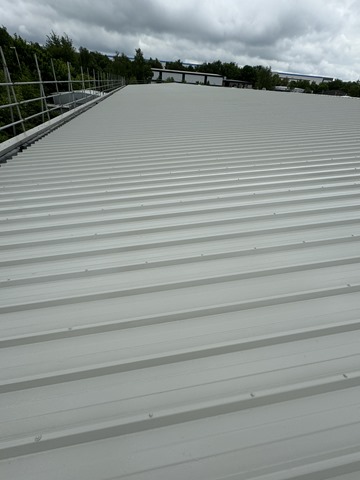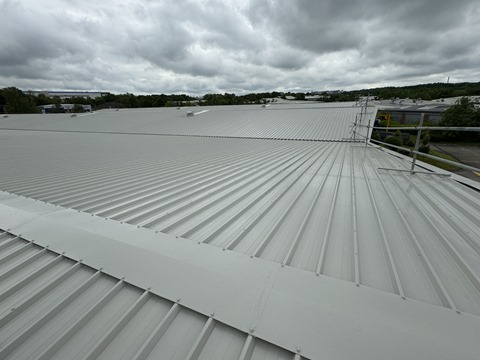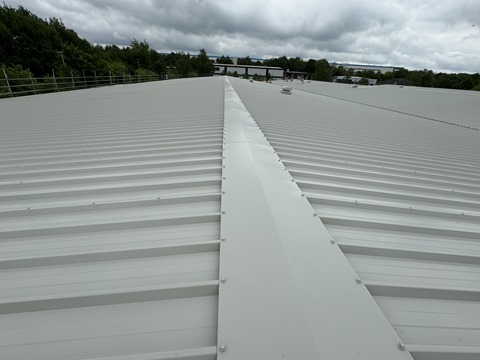- Metal Roof Refurbishment Project Case Study
The condition of this roof was quite poor, with many areas of the original finish affected by crazing and delamination, which is an indication of the need for maintenance recoating.
With a total surface area of around 11,000 sq metres, the installation commenced in March 2024.
The weather conditions during March, April were particularly poor, so during this time, only roof cleaning, repairs, surface preparation and priming could take place.
Surface preparation to the cut edges involvbed the complete removal of an existing and failing cut edge corrosion treatment.
Because the mid-laps had been sealed historically with a silicone sealant, the new cut edge corrosion treatment, which is a standard component of our metal roof refurbishment system, also required sealed mid-laps.
In this instance, HP Butyl Tape replaced the silicone sealant, as it is far stronger and more resistant to foot traffic.
The Metaslseal roof coating was applied when conditions allowed and each of the three spraying teams completed in excess of 1000 sq metres per day.
The project was completed by D&D Industrial Coatings Ltd.
Pre-Coating Remedial Works
Numerous repairs were specified by Liquasil’s roofing surveyors to bring the roof into a suitable condition including:
- Isolated splice repair & replacement sheets where cut edge corrosion had resulted in the sheet ends rotting away.
- Replacement of Dek-Tite seals, including the addition of apron flashings to allow a more robust seal.
- Replacement of numerous fixings which had become loose or misaligned with age and use.
- Replacement of numerous ridge, flashings and gutter closure details.
- Removal of existing, failed cut edge corrosion treatment that was trapping moisture and causing a significant, hidden defect throughout.
Liquasil metal roof coating specification
- The roof sheets should be thoroughly cleaned, with all existing finishes being fully and completely removed back to bare metal.
- Minimum 3000- 4000 psi jet wash with turbo lance (being the most effective cleaning and finish removal system), but alternative finish removal methods are available and can be used, subject to prior approval of the manufacturer and the Contract Administrator.
- If any original coating remains after cleaning, it should be examined to determine any signs of possible delamination. Cross-hatch adhesion testing should be undertaken to any residual finishes to ensure they are firmly adhered. This is no guarantee that they will not delaminate from the roof at some stage in the future, so complete removal is strongly recommended.
- To the cut edges and other previous coatings. Remove existing finishes/coatings using grinding or other suitable methods.
- Prepare all cut edges and all spot corrosion back to bare metal, but do not leave the surface shiny. (SA2½)
- Cut out any areas where the roof sheets have perforated or rotted. Consider splice repair or sheet replacement depending on condition.
- Apply a single coat of Liquasil SWT Corrosion Primer to the cut edges and spot corrosion. At the mid-laps, both the upper and lower sheets should be treated to the highest point of corrosion in a straight line at a wet film thickness of 125 microns. The band width of the corrosion primer should be approximately 250mm between the top and bottom sheets.
- Spot-corrosion should be treated with a single coat of Liquasil SWT Primer at a wet film weight of 125 microns.
- Prime underneath the lap at the eaves and mid-laps as far as reasonably practicable.
- Once cured and before over-coating, all primed areas should be wiped with Liquasil Solvent Wipe to ensure no surface contaminants remain. Surfaces MUST be bone-dry before proceeding to the next step.
- To seal the mid-lap joints, apply a 150mm band of Liquasil HP Butyl, Geotextile Faced Waterproofing Tape equally between the top and bottom sheets, so that the joints are fully sealed. The use of penny rollers is strongly recommended to ensure that the tape is firmly applied into creases and vertical elements of the sheet profile. HP Butyl Tape should not be directly trafficked after installation, as this will cause it to crease.
- Ensuring surfaces are bone dry, all primed and taped areas to be coated initially with Metalseal 20 at a wet film weight of 250 microns.
Sample Images From Original Roof Survey
Surface cracking & delamination of existing finish.
Delamination and failure of original metal roof finish
Cut edge corrosion treatment with rust breakthrough
Rust breakthough and staining from cut edge corrosion
Extent of corrosion beneath cut edge corrosion treatment
Poor quality spot corrosion repair on metal roof
Metal Roof Refurbishment Project Progress & Completion
Old cut edge corrosion treatment removed
Airless spray application of Metalseal 20
Partially completed section of Metalseal metal roof coating.
Completed section showing metal roof refurbishment
Elevation completed with Metalseal 20
Completed Metalseal installation
COMPLETED PROJECT GALLERY
A selection of drone and “on the roof” images taken as the project was completed. The finished project is covered by a 25 year Liquasil product warranty, as well as an insurance backed warranty supplied via the contractor.
The colour used on this project is Goosewing Grey.
Liquasil’s own team of building surveyors can help specifiers and end-user companies prepare a detailed specification document for the installation of Liquasil products.
This ensures that when tendering your metal roof refurbishment project, all of the companies will be providing their quotation based on the same information.
Please contact us or call 0121 709 5352 to discuss your potential roof refurbishment project. We will talk you through your options and can prepare a specifciation based on your own survey images, or we can attend site with you to inspect the roof and make suggestions for any remedial works that might be required to enable your roof coating project.

